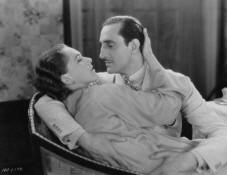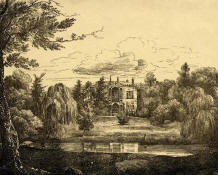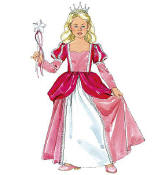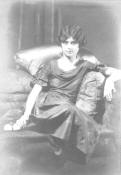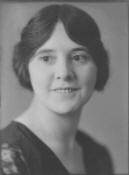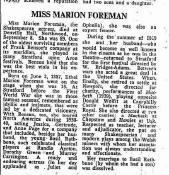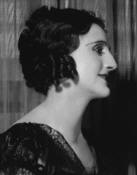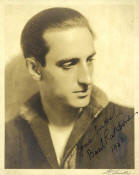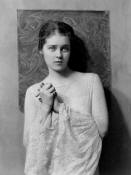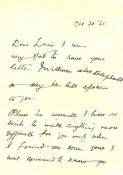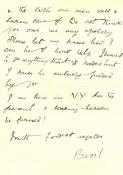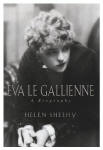Esther was possibly Basil's first girlfriend—at least the first one about whom he wrote. "Little Esther with her amorous odor of hay—the hayloft was at the farmhouse at the bend in the road, where we met wide-eyed, expectant, fearful, as we paused in a kiss ... loving and longing ... Esther's hair caressing my face ... my hands trembling with the willful impulse to explore the divine mystery of her being."1 While Basil didn't mention how old they were, the reference in the previous paragraph to Queen Victoria's death, which occurred in 1901, suggests that it was near that time. Basil was nine years old in 1901.
Basil met Cynthia at a Christmas party at Greenbank House (the home of his great-uncle William) in Liverpool in December 1902. He was ten years old and completely in awe of the little girl dressed as the Fairy Queen. Cynthia was wearing the Fairy Queen costume for a play the children performed at the party. Basil remembered every detail of her costume, and thought that she was the most beautiful Fairy Queen he had ever seen. "Her light brown hair framed her piquant little face, with its dark brown eyes, and a full warm mouth. Her whole being radiated an impertinent charm. I loved her as I was sure I would never love anyone else again in my life!"2 Basil learned that Cynthia lived next door to his grandmother (where he and his parents were staying for the Christmas holidays). In his mind, he made plans to see her again, to scale the garden wall, to run away together! "Somehow, everyone must be made to understand that I could not go on living without her ... I loved her so terribly!"3 Alas, it was not to be. Cynthia left with her parents for a vacation in St. Moritz the next day. "And we never spent another Christmas at Granny's either," wrote Basil, "Granny died in the spring."4
While serving in France during the Great War, Basil met a young beauty named Marie. His division had been taken "out of the line" (a respite from the trench fighting) and Basil and his batman were billeted in a farmhouse.6 The very first evening he was there, wrote Basil, "I met the farmer's daughter and promptly fell in love with her. There was something so gentle, wide-eyed, and sweet about her. ... She was the first pretty girl I had seen in a long time."7 Basil related how he yearned to be alone with her, but her mother and father were always there. Marie's father was suspicious of Basil. "Not that one could blame him—my intentions were definitely not honorable. ... I made violent love to Marie without once even touching her—while she would sit looking at me, smiling with those limpid eyes."8 Basil never did manage to seduce Marie--not for lack of trying, however. He had located her bedroom window and climbed a tree close by, only to discover it was the window to her parents' room! He remained rather obsessed with her, however. Weeks later, when he heard that her family's farmhouse had been heavily shelled, he borrowed his colonel's horse and rode out to see if Marie had survived. He was unable to find any trace of her, and the farmhouse had been reduced to a pile of rubble.
When Basil returned from the war, he and his wife separated. After the separation, "Marion refused to believe that we would not in due course come together again." He did not want his wife and son to suffer financially because of his decision to leave them. During this time Rathbone wrestled with a sense of guilt with regard to his son. He wrote: "Self-condemnation fought bitterly with self- justification, and there was no one to turn to and talk with about such intimate personal matters. ... my son was missing his father."9 In 1925 Marion Rathbone was granted a divorce from Basil on the grounds of infidelity. Marion's obituary (below) gives more details about this talented woman.
The romance of Basil and Joyce continued through the fall and winter of 1919-1920. Both of them were working; he was in the play Peter Ibbetson and she was another play. They were both busy and had few opportunities to be together. Their relationship began to suffer. Rathbone wrote, "The theatre is a hard life for lovers, and harder still for those who would make a successful marriage. 'Absence makes the heart grow fonder?'—I don't think so."12
Basil made no further mention of "Juliet" in his autobiography, but jumped ahead to early 1921, when he met "Kitten" at a party hosted by Ivor Novello. When he first laid eyes on the woman he dubbed "Kitten," Basil was taken aback by her startling resemblance to Marie, the French farmer's daughter. "Marie!" he blurted. She told him her name was Madge, and then suggested that they leave the party and go to her flat. Thus began a hot romance between Basil and his Kitten. He wrote that he called her that because she purred like a cat every time he kissed her. In additional to having a physical resemblance to Marie (same "downy soft eyebrows and artful blue eyes"), Kitten "had a divine sense of humor—she slept all day and was up all night"13 Basil continued to play with Kitten the rest of the year, until he sailed for New York City to star in his first play on Broadway—The Czarina.
The half-Danish, half-English LeGallienne had been involved in a lesbian relationship with Mercedes de Acosta; heterosexual relationships were unusual for Eva. In fact, her only known male lovers are Basil Rathbone and Joseph Schildkraut. Sheehy said that Eva “was attracted to Rathbone on every level—sexually, artistically, and spiritually. She adored his 'long aristocratic legs,’ his gentle nature, and they were both schooled in European and English theatre, loved the classics and shared artistic aspirations. . . . At one point, Le Gallienne told Mercedes that she thought of marrying Basil and having his child. Then in late October Ouida Bergere joined Basil in Chicago while they were playing The Swan there, and Le Gallienne had to compete for his time. I want to 'pry Basil away from Ouida,’ she wrote.”16 When Ouida wasn't occupying Basil's time, Eva and Basil continued their lovemaking. Their affair lasted about five or six months, until the spring of 1925. According to LeGallienne, she ended the affair when she overheard Basil bragging about sleeping with her. But according to Robert A. Schanke, another LeGallienne biographer, some of Eva's friends reported that Basil ended the relationship after Eva feared she might be pregnant (she wasn’t, in the end according to Schanke). Regardless of who ended it, Eva still had feelings for Basil. She wrote to her mother, “I still call him ‘my’ Basil, because I know that he really is. I miss him.”17 An interesting tidbit of information is that in September 1925 (at least six months after their affair ended), Basil ran into Eva at the theatre and surprised her by asking if he could visit her at home. She was puzzled, but agreed. Maddeningly, that's all that is known. Did they meet? Why did Basil want to see her? Unfortunately, we'll never know.
In the fall of 1924 Basil met a beautiful young woman named Louise (or Louie, as he called her). Basil was touring the USA with The Swan; Louise was working at the theatre in one of the towns on the tour. One thing led to another . . . and they ended up spending the night together. When it was time for the cast of The Swan to move on to the next town on the tour, Basil said good-bye to Louise. But he later learned that Louise was pregnant! His illegitimate daughter was born in the summer of 1925. Ever the gentleman, Basil acknowledged the child as his own. He sent Louise the following letter: Basil accepted his responsibility for the baby to the extent of sending the family money. He also visited the child on at least three occasions and told her that he would have liked to see her more often, but he wasn't able to.
.
.
|
||||||||||||||||||||||||||||||||||||||||||||||||||||||||||
| Basil Rathbone: His Life and His Films, by Michael B. Druxman (Hardcover: South Brunswick and New York: A.S. Barnes, 1975) Paperback edition: BearManor Media, 2011. | |
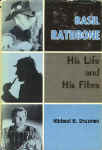 |
Mr. Druxman's book is well-researched and
well-written--a "must have" for every Basil Rathbone fan. The book traces the
fascinating life of the actor and provides detailed descriptions of all of Rathbone's
films, including cast, credits, critics' reviews and production notes.
Out-of-print for more than thirty-five years, Michael Druxman’s book is once again available
for purchase.
This new reprint edition mirrors the original 1975 biography/filmography,
including its more than 250 rare photographs, and also contains a new
Introduction by the author. Buy it at Amazon.com.
|
| In and Out of Character: An Autobiography, by Basil Rathbone (New York: Doubleday, hardcover, 1962). Paperback edition, 2004. | |
| Basil Rathbone proves that he is as good a writer as he
was an actor. In his autobiography Rathbone reveals many facts about his personal life,
and also tells anecdotes about fellow actors and actresses he worked with. This book is
currently available. Check out Amazon.com. |
|
| Eva LeGallienne: A Biography, by Helen Sheehy (Knopf, 1996). Kindle edition: 2011 | |
|
The extraordinary life of one of the great actors of the 20th century is
viewed in this complex biography, including her protean career and
courageous and controversial private life. This is the second biography
of Le Gallienne to appear in recent years, and Helen Sheehy tackles her
larger-than-life subject with verve and thoroughness. Sheehy's account
of Le Gallienne's life, drawn mostly from the actress's personal papers,
is the perfect combination of professional triumphs and defeats and
personal anecdotes. Le Gallienne's childhood is well documented here,
but Sheehy refrains from covering insignificant events. She shows how Le
Gallienne's parents' tempestuous marriage, which ended in bitter
divorce, helped lay the foundation for many of her own adult
relationships.
Buy it on Amazon.com. (Click here for the Kindle edition.) |
|
.







